
Some Words About Pickups

![[Previous Page]](prev.gif)
![[Next Page]](next.gif)
![[Up]](up.gif)
![[Home Page]](home.gif)
![[Mail]](mail.gif)
![[Contents]](contents.gif)

First I want to talk about some rumors about pickups...
There are no mirical pickups! It's all physics and pretty easy to understand. A pickup with a certain sound has a certain characteristic which results from the materials that are used and the way it is wound.
All pickups have the same reaction, they work with the speed of light. No pickup provides a longer sustain.
To descibe how pickups work and what causes the different sound of pickups, I have to mess around with electronics a little bit.
If you don't know much about that matter, just ignore what you don't understand.
How does a pickup work?
Actually a pickup is a wire (a coil) wound around magnets. The magnets cause a constant magnetic field. You might remember from school, that a changing magnetic field causes an electric current in a coil - this is the way every generator or dynamo works. The field of the magnets is a contant one, so nothing happens.
On a guitar, the strings are placed over the little magnets and are made from magnetic material. Thus they influence the magnetic field. Still nothing happens.
When the strings are picked, they start to vibrate and since they influence the magnetic field, it starts oscillating too. Now something happens. An oscillating current with the same frequency of the strings is induced in the coil around the magnet, flows through the cable into the amplifier, is amplified and flows through the speaker. This is the sound you hear.
What is the difference between a single coil pickup and a humbucker?
One problem with those magnetic pickups is the undesireable noise, the humming. This is cause from all the electric appliances and equipment that is always around. What happens is that they produce an oscillating electro-magnetic field, usually with a freqency of 50 or 60 Hertz (depends on where you live). This magnetic fields cause a current in the coil of the pcikup, too. From there you hear a humming sound. The closer you get to the electric equipment, the louder it is (just remember what happens when you get close to yer amplifier).
There is naerly no way to really prevent this with an ordinary single coil pickup.
A humbucker, however, can reduce the noise a lot.
A humbucker is a pickup made of two coils, that a re wounds in two different directions. The undesireable current caused by all those electro-magnetic fields is induced in both coils, but has different polarities in each coil. Thus it (nearly) cancels out.
The magnets through the two coils of humbuckers have different polarities. The north pole is pointing up in one coil, and the south pole is pointing up in the other coil. This is why the desired current caused by the vibrating strings adds up.
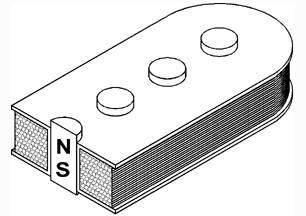
Single Coil Type I |
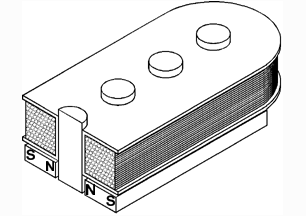
Single Coil Type II |
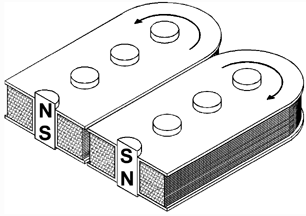
Humbucker Type I |
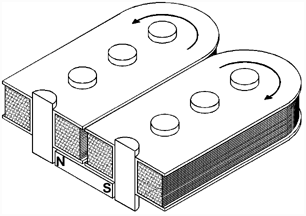
Humbucker Type II |
There are different types of pickups. Some have magnet cores (Type I, typical Fender p/u) and some have iron cores with magnet bars on each side (Type II, typical Gibson p/u).
Why do different pickups sound different?
If a coil would be an ideal inductivity, the difference would be just the volume. That would be simple but boring!
C oil is made from wire, which definately also acts like a resistor. There are many windings on a pickup, so the wire is pretty long. That results in an impedance of 1 to 20kOhms. Also there is a capacity between the windings. A schematic that describes a pickup pretty good consists out of an inductivity (L), a resistor (R) and a capacitor (C).
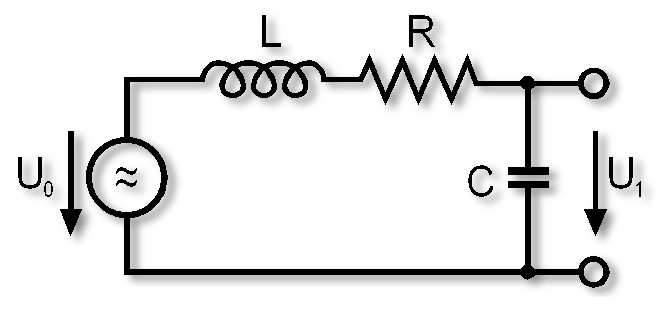
The people who know a bit about electronics will notice, this is a low pass filter (with 2 poles). Low frequencies will pass the low pass, high frequencies will be attenuated.
Thge more windings on a pickup, the more L, the more R and the more C you will get. Thus the cut off frequency will be lower. This is why humbuckers which have more windings will sound darker.
BTW: A vibrating string produces a variety of frequencies. There's the fundamental wave plus the harmonics (which are higher frequencies). If a guitar would produce just one frequency (a sine wave without harmonics) it would sound like a recorder. This mixture of frequencies are forming the tone. If the harmonics are influenced differently, the sound is different.
U0 are the frequencies produced by the strings, U1 are the frequencies result after passing the pickup.
A typical pickup characteristic looks like this:
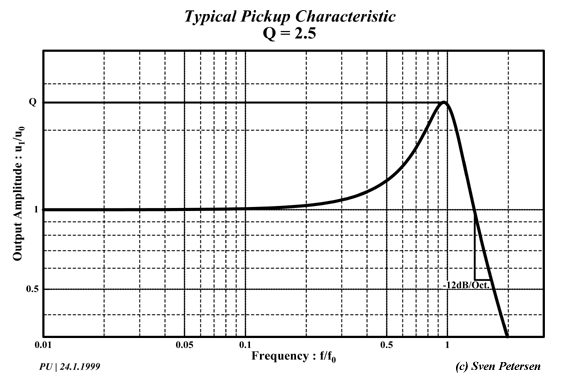
There is a peak in this charatceristic, which causes the distinct sound of a pickup.
There are two significant values, that fully describe this characteristic. That's f0 and Q. Both can be calculated out of L, R and C of the p/u schematic mentioned before.
f0 is (approximately) the peak frequency and Q is (approcximately) the amplification of this peak. All frequencies that are higher than f0 are attenuated (it's a low pass).
Different pickups have different values for f0 and Q. This is why they sound different. Usually f0 varies between 2 and 5 kHz, Q between 1 and 4.
An f0 of 2kHz sounds soft, maybe dark, 3kHz sound brilliant, 4 - 5kHz sound shrill or piercing and f0 above that sound pretty harsh and cutting.
A low Q resulty in a flat sound, a middle range Q sounds expressive and a too high Q will sound shrill.
Here are the values of some pickups:
| Pickup | L Henry |
R kOhms |
C pFarad |
f0 kHz |
Q |
| Fender Strat (old) | 2.2 | 5.7 | 110 | 4.4 | 2.1 ... 6.3 |
| Fender Strat (new) | 2.8 | 4.7 | 60 | 4.2 | 1.4 ... 3.1 |
| Squire Strat | 4.6 | 7.9 | 170 | 2.9 | 1.3 ... 2.4 |
| Fender Jazz Bass | 3.6 | 7.8 | 150 | 3.4 | 1.6 ... 3.9 |
| Fender Humbucker | 5.0 | 10.8 | 80 | 3.0 | 1.4 ... 3.1 |
| Gibson P90 | 6.4 | 13.3 | 80 | 2.7 | 1.3 ... 2.9 |
| Gibson Humbucker Standard |
3.8 | 7.6 | 130 | 3.3 | 1.3 ... 2.0 |
| Gibson Mini Humbucker |
3.8 | 6.8 | 140 | 3.3 | 1.3 ... 2.2 |
| Gibson Super Humbucker L6S |
6.0 | 5.8 | 100 | 2.8 | 1.3 ... 2.3 |
Q and f0 are measured with a load capacitance of approximately 470pF, which is introduced by the guitar cord.
This characteristic is also influenced by the cable, which adds some capacity (C) and the input impedance of the amp. The lower this impedance, the lower the peak. A unsuitable cable can change the sound in a noticeable way. Some old guy told me, that in former time the guitars were delivered with a cable that fits teh characteristic of the pickup best. Personally, I make my own cables in different lengths and don't use too long cables.
The sound of an electric guitar does not only depend on the pickups. The body, the neck and the strings also take (a major) influence on the sound. You need suitable pickups to get the best sound out of yer guitar, though.
What's the best distance between the strings and the magnets?
The distance between the strings and the magnets can be adjusted at most pickups. Some pickups allow to adjust the distance for every magnet. Those magnets look like small screws. Most pickups are mounted in the guitar in a way so that the distance between them and the strings is adjustable.
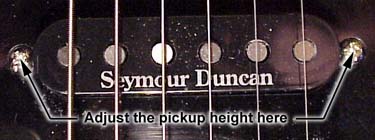
The closer the distance between magnets and the strings, the louder is the the tone. The goal should be matching the volume of all pickups and all strings.
If the magnets are too close to the strings, they introduce a force on the strings that influences the vibration of the strings. This will degrade the tone.
What's are microphonic pickups?
A microphonic pickup kinda works like a microphone, too. This is a non-desired effect, which might even cause a screaching feedback noise, when the guitar is played very loudly.
It is caused by slack windings, that can move when the pickup is shaken.
It's pretty easy to find out, if a pickup is microphonic. Hook the guitar to the amp, while there are no strings on it (next time you string i). If you get some pretty loud sounds when knocking on the body, the switched on pickup is too microphonic - maybe every pickup is slightly microphonic.
Modern pickups are usually not microphonic, they are machine-wound and the windings are tight. Older, hand-wound pickups might show this effect, though.
This can be fixed by waxing the pickup. That's putting the pickup into hot wax. The wax will creap into the coil and fix the windings.

| [Previous] | My guitar and gear page |
| [Next] | Improving a guitar (electrically) |
| [Up] | Home Page |
| [Home] | Home Page |
| [Mail] | Send EMail to Sven's Guitar Zone |
| [Contents] | Sven's Guitar Zone Contents |

Last modified on Wednesday, 22. February 2006